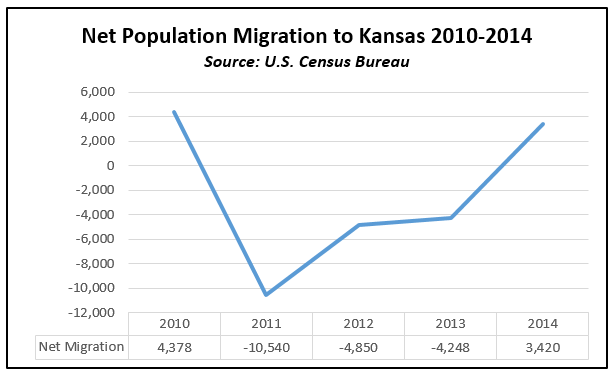By now every sports fan is familiar with the NFL’s use of instant replay in the relentless pursuit to get calls correct. This practice has been around for almost two decades now because sometimes a single look at a play is not sufficient to provide all the information necessary to get it right. Some plays just need closer scrutiny.
 Like the Chiefs’ Andy Reid challenging an egregious call, KPI is throwing the red flag on the report Kansas Public Education: The Foundation for Economic Growth, recently published by the Kansas Center for Economic Growth (KCEG). In this recent blog, KPI took issue with the basis of the report: that the recent income tax cuts in Kansas should be repealed so more money could be spent on education.
Like the Chiefs’ Andy Reid challenging an egregious call, KPI is throwing the red flag on the report Kansas Public Education: The Foundation for Economic Growth, recently published by the Kansas Center for Economic Growth (KCEG). In this recent blog, KPI took issue with the basis of the report: that the recent income tax cuts in Kansas should be repealed so more money could be spent on education.
This analysis goes “under the hood” to examine, challenge and ultimately overturn many of the details KCEG provided to support their flawed thesis.
- KCEG: “Kansas faces big challenges…We are not talking about the investments necessary to fund K-12 education.” (emphasis not added)
- After further review: KCEG never defines “investments necessary to fund K-12 education.” Why? Because their agenda is to get more money to public education with no accountability, no questions asked. But the finance facts are these: going back to 1992, per-pupil funding to education has increased 45% above the inflation rate, now to an all-time high of over $13,000 per pupil, per year.
- KCEG: “Replace block grant funding with a school funding formula built for success.”
- After further review: This sounds like a good thing, but a funding formula is just the delivery device for providing money to schools across the state. Again, this is just KCEG code for more money. How the money is spent – the “built for success” part – is up to local school boards. They are the ones responsible for using the dollars wisely to prepare students for a future career. Local control over how money is spent is revered in Kansas and the legislature, the State Board of Education, and KSDE are careful not to interfere.
- KCEG: “(T)he state’s public schools attract talented workers to Kansas who want their kids to receive a strong education. This effect is enhanced when that hope is fulfilled. Those graduating students find a job in Kansas and, eventually, send their own children to one of Kansas’ world-class public schools.”
- After further review: This is little more than quaint sentiment that doesn’t even reconcile with their underlying premise. How can KCEG express that Kansas has “world-class schools,” yet say they do not have the funds available to adequately prepare students for college and career? First of all, according to the most recent Education Week’s Quality Counts report, Kansas schools received a “D” in achievement. Of the college-bound graduates from our “world class” high schools, only 32% meet college readiness benchmark scores on the ACT. These are facts far from indicative of “world class” status. The inconvenient truth is that overall, Kansas schools perform about average in a country of mediocre performance.
- KCEG: “(B)etween 2012 and 2022, the Kansas Department of Labor projects almost 35,000 job openings in Kansas per year will require at least a high school diploma or equivalent. The average number of high school graduates per year since 2007, however, falls at only about 33,700. This leaves 1,300 jobs unfilled because too few students graduate.”
- After further review: This statement requires pretzel logic to accept. First off, assuming the jobs numbers are correct, many of
 those openings have and will be filled by recent college grads and other adults who are not recent high school grads. Duh. But what is even more curious is they seem to forget that a majority of high school graduates immediately enroll in college. According to the U.S. Department of Education statistics about two-thirds of Kansans enroll in college immediately after graduation. Using KCEG’s numbers, that would leave only about 11,000 high school graduates available to enter the workforce. Applying their pretzel logic, it’s a good thing there aren’t double the job openings each year or Kansas schools would look really bad.
those openings have and will be filled by recent college grads and other adults who are not recent high school grads. Duh. But what is even more curious is they seem to forget that a majority of high school graduates immediately enroll in college. According to the U.S. Department of Education statistics about two-thirds of Kansans enroll in college immediately after graduation. Using KCEG’s numbers, that would leave only about 11,000 high school graduates available to enter the workforce. Applying their pretzel logic, it’s a good thing there aren’t double the job openings each year or Kansas schools would look really bad.
- After further review: This statement requires pretzel logic to accept. First off, assuming the jobs numbers are correct, many of
- KCEG: “One of the exacerbating factors for this estimated labor shortage may be the out-migration of people from Kansas as current tax policy threatens our quality schools, roads, and communities. Indeed, in the first full year of the tax cuts, 4,200 more people left Kansas than moved to Kansas.”
- After further review: This is a great example of how point-in-time data can be misused to substantiate a false assertion and begs for closer inspection. Although KCEG is careful to parse their words so as not to say that the income tax cuts actually caused people to move out of state, it is clear what they imply. However, that claim does not hold up when examining the bigger picture. According to U.S. Census data, it is true that Kansas had a net migration loss of more than 4,200 people in 2013, which was the first full year of the income tax cuts. But they left out two pesky little truths provided in the graph below: (1) the net migration loss in 2013 was actually less than those of the previous two years – years prior to the tax cuts and (2) data for 2014, which saw Kansas have a net gain in migratory population was suspiciously left out of their report.

- After further review: This is a great example of how point-in-time data can be misused to substantiate a false assertion and begs for closer inspection. Although KCEG is careful to parse their words so as not to say that the income tax cuts actually caused people to move out of state, it is clear what they imply. However, that claim does not hold up when examining the bigger picture. According to U.S. Census data, it is true that Kansas had a net migration loss of more than 4,200 people in 2013, which was the first full year of the income tax cuts. But they left out two pesky little truths provided in the graph below: (1) the net migration loss in 2013 was actually less than those of the previous two years – years prior to the tax cuts and (2) data for 2014, which saw Kansas have a net gain in migratory population was suspiciously left out of their report.
- KCEG: “In a 2014 survey of Kansas public school superintendents, KCEG documented how insufficient state investment in K-12 public education affected schools. Results showed that average class sizes increased, funding per pupil decreased, and extracurricular activities, athletics, art, and music programs had been reduced or eliminated.”
- After further review: As KPI reported here, over the past decade, teacher hiring has outpaced student growth 5.4% to 4.8%, yet class sizes have increased. The fact that class sizes have increased is a function of local school district decisions, not a lack of funding. The superintendents’ beliefs that per-pupil funding has decreased is discredited by official financial data provided by KSDE. KCEG conveniently fails to mention which districts have reduced or eliminated many services, because most districts have healthy cash reserves that they choose not to spend on those programs and activities.
- KCEG: “At the local level, Kansas public schools made significant changes to cope with years of funding that failed to meet the needs of their students. Here is a sampling of what districts had to do in 2015 just to balance their budgets.”
- “Six school districts ended their 2014-15 school year early because of low funding provided by the state in the form of block grants.”
- After further review: As KPI exposed in this blog, schools chose to utilize the unused snow days in 2015 to ‘shorten’ the school year, which they were able to without violating state minimum time-in-school requirements. (Look for this to be repeated in 2016, due to another mild Kansas winter.)
- “Chetopa-St. Paul (USD 505) moved to a four-day school week, causing working parents to pay for unexpected child care costs.”
- After further review: Yes, that school board’s decision caused an imposition on parents, but they could have made other choices, such as adjust staffing, which increased 92% over the last ten years while enrollment rose 54%.
- “Andover (USD 385) enacted a combination of budget cuts and student fee increases, doubling the cost for some kids to ride the bus to school.”
- After further review: USD 385 added $3.5 million to cash reserves over the last ten years, and the fee they charge for riding a bus only applies to those living too close to school to qualify for free transportation. Why would money be diverted from instruction to underwrite an optional service?
- “Kansas City, Kansas (USD 500), reduced all school and department budgets by 10 percent, cut $350,000 from textbook purchases, and eliminated $900,000 in funding for alternative services, such as the KVC Academy program.”
- After further review: USD 500 still increased per-pupil spending by 58% over the last ten years, used $35 million in aid to increasing operating cash reserves and increased staff by 24% while enrollment only grew by 7%. They had many other choices to improve upon efficiency without cutting programs.
- “Tonganoxie (USD 464) eliminated a popular middle school music teacher’s position, cut paraprofessionals and ninth-grade sports, and increased fees for kindergarten and technology.”
- After further review: USD 464 could have chosen to reduce Administrative costs which increased 40% over the last ten years or question the need for a 79% staff increase with only a 21% increase in enrollment; non-teaching staff jumped 97%!
- “Winfield (USD 465) cut the graduation completion program – one of the most important avenues for people who didn’t finish high school to earn a diploma.”
- After further review: : Rather than cut what they consider to be an important program, USD 465 could have addressed multiple operational inefficiencies; over the last ten years Administration spending per-pupil climbed 39%, Food Service increased 51% and Transportation jumped 63%. And despite an 11% enrollment decline, they increased non-teaching staff by 15%.
After emerging from under the hood, veteran NFL referee Ed Hochuli, would say:





